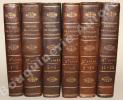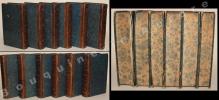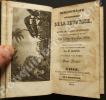4 books for « chardin john »Edit
-
Century
18th (1)
19th (1)
20th (1)
-
Topics
Atlas (1)
Chardin (4)
Gastronomy (1)
Iran - persia (1)
Travel (2)
-
Countries
Belgium (1)
Denmark (1)
France (2)
-
Syndicate
ILAB (3)
SLAM (2)
Voyages du Chevalier Chardin, en Perse, et autres Lieux de L'Orient. Enrichie de Figures en Taille-douce, qui représentent les Antiquités & les Choses remarquable du Païs. Nouvelle Edition. Vol. 1-3 (of 4 = ""Supplement""). l. Paris á Ispahan - 2. ...
A Amsterdam, 1735. 4to. 3 cont.full mottled calf. Raised bands, richly gilt backs. Extremities with small traces of use, slight weakening to parts of hinge, top of spine on vol. II with loss of leather ca 1x2 cm. Internally fine on good paper. 2 engr.frontisp. (with portraits), 3 engr.titlevign., 3 large engr. textvignettes. (12),390,(4),359,(4),437 pp. and 78 mostly large folded engraved plates (maps,plans,views etc.). - To this second edition was published a 4th volume which contains the author's previously published work ""Couronnement de Soliman III"" and extracts from the author's manuscript, this supplementary volume is not present here, but the 3 volumes contain the whole travel and all the plates belonging to these 3 volumes.
Rare second edition of Chardin's travels, regarded as being one of the finest works of early Western scholarship on Persia and the Near East in general. ""Thought to have been read by writers such as Montesquieu and Rousseau, Chardin's account stands apart from those of other travellers to the region (Caucasus) at this time through its awareness of cultural difference and relativity and in its desire to place accuracy above romanticism."" (Speake, The Literature of Travel and Exploration, 1).Chardin set out from Paris for Persia and India. He reached Ispahan 1673, spent four years in Persia, visited India and returned by the Good Hope in 1677. The first volume contains the trip from Paris to Isfahan, the second contains a particular description of Isfahan and the relation of the author's two voyages, from Ispahan to Bander-Abassi, the third contains a general description of the Persian empire and the particular descriptions of the sciences and arts which are in use therein, of political, military, and civil government.Born in Paris in a Hugenot (Protestant) family, Jean Chardin (1643-1713) undertook his travels to Persia because of his father's position as a jeweler and shareholder in the French East India Company. The younger Chardin set out in 1664, traveling through Turkey, the Black Sea, Georgia and Armenia. Soon after his arrival in Persia, he received a commission to create jewelry for Shah Abbas II, who died in 1666 and was succeeded by Shah Safi. After witnessing the latter's coronation, Chardin went on India and finally returned to Paris in 1670. In 1671, he published an account of the coronation and in the same year set off for Persia again, arriving in Isfahan in 1673 and remaining there for several years, before once more visiting India and returning home in 1677. With the persecution of the Hugenots in France, he moved to England in 1680""Travel restarted with 17th-century missionaries, whose medical and pedagogical expertise helped counterbalance Orthodox (or pagan) reservations. Dominican Prefects Dortelli D'Ascoli and Giovanni da Lucca (1630s) extended Giorgio Interiano's description of Circassia (and Abkhazia). Theatine proselytisers targeted Mingrelia/western Georgia (Capuchins the eastern provinces) - the Vatican's Fide Press further contributed by printing the first Georgian books (Chikobava/Vateishvili). Many, including mission-head Don Pietro Avitabile (1626-1638), recounted their experiences. Prefect to Mingrelia, Joseph Marie Zampi, a 23-year denizen from approximately 1645, contributed a third significant source in his description of Mingrelian religious practice. This he handed to Jean Chardin (1643-1713) in 1672. A French traveller who became English(!) ambassador in Holland, Chardin translated and incorporated it as a substantial part of his own description of a sometimes perilous journey through Transcaucasia (1672-3), which reflects Ottoman and Persian influence in western and eastern parts, respectively - a Turkish organized slave-trade flourished from various Mingrelian ports. Linguistically, Zampi revealingly observed that the ecclesiastical language, Georgian, was as difficult for even the Mingrelian priesthood to understand as Latin was for Italian peasants!"" (Speake, The Literature of Travel and Exploration, 1, 199-202).Brunet 1802Graesse II, P. 121
Sir John Chardin's travels in Persia
Amsterdam / New York, N. Israel / Da Capo Press 1971 xxx + 287pp.with ills. + plates out-of-text, 26cm., in the series "Argonaut press" vol.3, reprint of 1927-edition (which was a reprint of the 1720-edition), cloth, VG, X71328
Voyages du chevalier Chardin en Perse, et autres lieux de l’Orient. Enrichis de figures en taille-douce, qui représentent les antiquités et les choses remarquables du pays. Nouvelle édition, augmentée du Couronnement de Soliman III & d’un grand nombre de Passages tirés du Manuscrit de l’Auteur, qui ne se trouvent point dans les Editions précédentes. Première édition complète des Voyages du chevalier Chardin en Perse et autres lieux de l’Orient, « augmentée du Couronnement de Soliman III & d’un grand nombre de Passages tirés du Manuscrit de l’Auteur » et ornée de 79 superbes gravures hors texte.
Cette édition est ornée de 79 gravures hors texte dont 51 dépliantes, de 2 frontispices et de 4 vignettes en tête. Amsterdam, aux dépens de la Compagnie, 1735. 4 tomes en 2 volumes in-4 de : I/ (7) ff., 390 pp., (1) f. bl., (2) ff., 359 pp, 1 frontispice, 61 planches, 2 cartes et 2 vignettes dans le texte ; II/ (3) ff., 437 pp., (3) ff., 324 pp., (15) ff., 1 frontispice, 16 planches et 2 vignettes dans le texte. Veau fauve mosaïqué, plats entièrement ornés d’un double encadrement mosaïqué alternant veau brun et veau fauve avec panneau central plus foncé, le tout souligné de roulettes et fleurons estampés à froid, filet doré d’encadrement, dos à nerfs richement ornés, tranches mouchetées. Reliure anglaise de l’époque. Marques d’appartenance de deux bibliothèques sur les feuillets de titre. 247 x 195 mm.
Première édition complète des voyages de Chardin en Perse, augmentée de plusieurs passages et du couronnement de Soliman III. Brunet, I, 1802 ; Chadenat, I, 1566 ; Schwab, Bibliographie de la Perse, n°87-88 ; Wilson p.40 ; Atabey 220 ; Diba p. 238. Le Couronnement de Soliman III confère un intérêt particulier à la présente édition. « Cette relation, dit Boucher de la Richarderie, n’a point été insérée dans les éditions des voyages de Chardin en 1711 et 1723. Elle ne se trouve que dans la dernière édition de ses Voyages, donnée après sa mort en 1735.- Très rare ». (Bibliographie de la Perse). « Le témoignage unanime des voyageurs qui, depuis Chardin, ont visité et décrit les mêmes contrées, n’a servi qu’à constater la justesse, la profondeur de ses observations, la variété de ses connaissances et sa véracité […] La première édition de ses voyages, publiée à Londres en 1686 in-folio, ne contient que le voyage de Paris à Ispahan ; elle n’a pas été continuée parce que l’auteur partit pour la Hollande où il publia 2 autres éditions, à peu près complètes de son Voyage en Perse. Nous disons à peu près complètes car le libraire Delorme exigea de l’auteur la suppression de certains passages capables de déplaire au clergé romain, et d’empêcher le débit de l’ouvrage en France. Ces passages ont été réintégrés dans l’édition de 1735, 4 volumes in-4 ». (Biographie universelle, VII, 506). Cette édition est ornée de 79 gravures hors texte dont 51 dépliantes, de 2 frontispices et de 4 vignettes en tête. Le tome 2 présente des tableaux dépliants atteignant jusqu’à 190 cm de longueur et représentant les bas-reliefs d’un temple des ruines de Persépolis. Chadenat mentionne à propos de cette édition « 79 belles planches repliées : cartes, vues, scènes, etc. ». Il précise qu’il possède « une très belle édition, dans une jolie reliure [en veau jaspé avec un compartiment de veau clair sur les plats], de cet ouvrage estimé ». Fils d’un joaillier de la place Dauphine à Paris, Chardin partit en 1665 pour les Indes dans le but accessoire d’y faire le commerce des diamants, et surtout entraîné par la passion des voyages. Il traversa la Perse, visita Surate, Ormus, et revint se fixer à Ispahan, où il séjourna 6 années et où le Schah Abbas II le nomma son « marchand ». « Sa position officielle, ses relations avec les principaux personnages, la connaissance qu’il s’empressa d’acquérir des idiomes du pays, lui permirent de recueillir une multitude de renseignements sur le gouvernement, les mœurs, les antiquités, les monuments et l’histoire de la Perse. Un dessinateur habile, qu’il avait amené, l’accompagnait dans toutes ses explorations, et il put rapporter ainsi des reproductions exactes des monuments, des costumes, des ruines de Persépolis, des armes, des ustensiles, … On a prétendu que l’académicien Charpentier avait aidé Chardin dans la rédaction de son livre. Quoiqu’il en soit, ce qui appartient incontestablement à l’illustre voyageur, ce sont ces matériaux précieux recueillis avec tant d’intelligence et de courage, ces recherches profondes, ces observations, ces renseignements curieux et authentiques sur l’histoire, l’administration, la législation, les mœurs, les sciences, les arts, les usages d’un pays pour ainsi dire inconnu jusqu’alors. Le témoignage unanime des voyageurs, dit Langlès, qui, depuis Chardin, ont visité et décrit les mêmes contrées, n’a servi qu’à constater la justesse, la profondeur de ses observations, la variété de ses connaissances et sa véracité ». « Ce voyage est un des plus intéressants que l’on ait publiés dans le siècle dernier. Cette edition est encore assez recherchee […] et elle se trouve difficilement » mentionne Brunet. Bel exemplaire, à belles marges, orné de 79 superbes gravures à pleine page, conservé dans son élégante reliure de l’époque en veau mosaïque.
[CAMPE (Joachim Heinrich), compilateur] - BRETON DE LA MARTINIERE (Jean-Baptiste Joseph), Traducteur.COOK (James) - BOYD (Hugues) - BARROW (John) - MUNGO-PARK - WILSON (Capitaine) - BARRINGTON - CHARDIN.
Reference : 13423
(1827)
Bibliothèque géographique de la jeunesse, ou Recueil de voyages intéressans dans toutes les parties du monde, enrichis de cartes géographiques coloriées et de vignettes ; traduits de l'allemand et de l'anglais, et mis à la portée des jeunes gens par M. Breton.Première série - 2ème année - Tomes Premier à Douzième : Année complète.
1827 P., Chez G. Dufour et Ed. D'Ocagne et Amsterdam, même maison de commerce, 1827, 12 tomes reliés à l'époque en 6 vol. in-18 (136 x 85 mm) 1/2 basane marron, dos lisse, titré "Recueil de Voyages intéressans" et tomaison dorés, plats de papier marbré bleu, tranches marbrées, pagination sur demande.Mors légèrement épidermés, quelques rousseurs éparses, bel exemplaire.
Tomes 1 à 12 de la deuxième année de la première série (année complète) de ce recueil de voyages destiné à la jeunesse, traduit de la compilation donnée par l'allemand Joachim Heinrich Campe par Jean-Baptiste Joseph Breton de la Martinière.Ces tomes contiennent : - Tomes 1 à 3 : Relation d'un voyage autour du Monde, depuis 1768 jusqu'en 1771, par James Cook, Lieutenant de Vaisseau Anglais, par MM. Banks et Solander, naturalistes distingués. (3 vignettes en frontispices).- Tome 4 : Ambassade de M. Hugues Boyd, à Candy, capitale de l'île Ceylan, en 1782. (1 vignette en frontispice).- Tome 5 : Voyage dans les contrées méridionales de l'Afrique, par John Barrow ; en 1797 et 1798. (1 carte dépliante aux contours coloriés : Afrique par Hérisson).- Tome 6 : Voyage de Mungo-Park, dans l'intérieur de l'Afrique, en 1795, 1796 et 1797. (1 vignette en frontispice).- Tome 7 : Naufrage et séjour du Capitaine Wilson, aux isles Pelew, en 1785. (1 vignette en frontispice).- Tome 8 : Voyage et transportation du fameux Barrington à Botany-Bay, dans la Nouvelle-Hollande. (1 vignette en frontispice).- Tomes 9 à 12 : Voyages de Chardin, en Perse, et autres lieux de l'Orient. (3 vignettes en frontispices et 1 carte dépliante aux contours coloriés : Carte de la Perse, de la Turquie d'Asie, de la Géorgie et d'une partie de la Russie asiatique, par Hérison (bords légèrement écornés)).
 Write to the booksellers
Write to the booksellers








